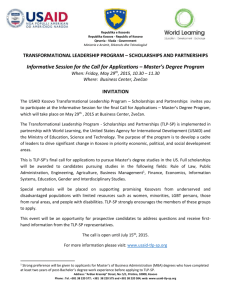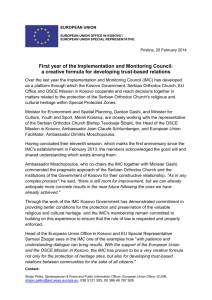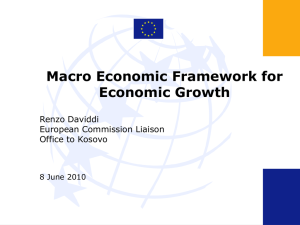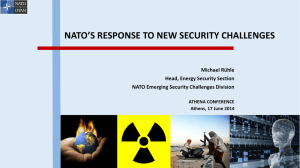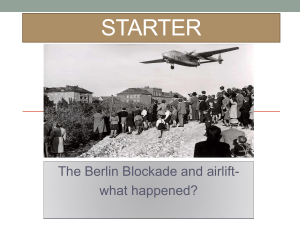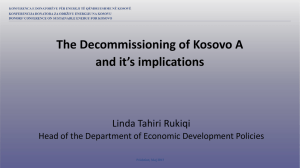university of illinos at urbana-champaign
advertisement
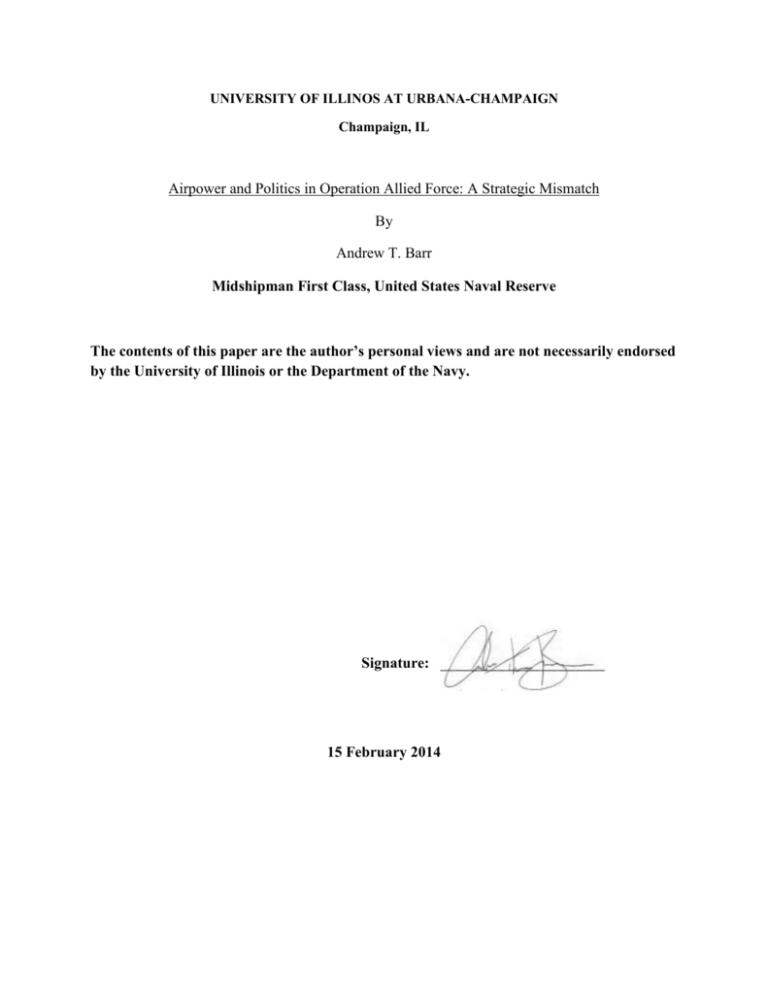
UNIVERSITY OF ILLINOS AT URBANA-CHAMPAIGN Champaign, IL Airpower and Politics in Operation Allied Force: A Strategic Mismatch By Andrew T. Barr Midshipman First Class, United States Naval Reserve The contents of this paper are the author’s personal views and are not necessarily endorsed by the University of Illinois or the Department of the Navy. Signature: 15 February 2014 2 The extensive use of NATO airpower in Kosovo and Serbia directed toward halting President Slobodan Milosevic’s ethnic cleansing operations remains a subject of controversy and scrutiny regarding the coercive use of armed force. Though victory was ultimately achieved, perhaps, as some like Michael D. Phillips have argued, “by accident”, the means through which the military fulfilled NATO’s objectives highlights the limitations of employing armed force.1 This paper will examine several factors that greatly impacted the conflict: differences in political and military objectives, the so-called “CNN effect” of popular media on foreign policy, the rise of force protection ideals, and debate over the “Powell Doctrine” (the belief that war must be a last resort, and only entered into with “overwhelming force”)2 as well as internal elements such as Milosevic’s belief in the potential for a NATO ground invasion and actions of Serbian paramilitary groups. This paper argues that these factors exacerbated the mismatch between the application of coercive airpower and NATO’s objective; the capitulation of the Milosevic regime rather than its total destruction. Indeed, although these dynamics aligned in such a way that allowed the NATO’s air campaign to succeed, had these factors manifested differently, Operation Allied Force’s (OAF) reliance on armed force, specifically air power, as a means of coercion would not have proven successful. NATO’s initiation of what would become a two month-long bombing campaign of “humanitarian intervention” came after the failure of multiple attempts at a diplomatic solution to stop 'the excessive and indiscriminate use of force by Serbian security forces and the Yugoslav Army' against ethnic minorities and political opponents.3 From the onset, the use of NATO airpower in Kosovo was based on political objectives which did not directly translate to militarily-achievable realities. These aims were articulated in a statement issued at the Extraordinary Meeting of the North Atlantic Council of 23 April 1999.4 The statement called for an immediate ceasefire, the departure of Serbian security forces from Kosovo, the establishment of an international military authority within Kosovo, the unconditional return of all refugees, and the creation of a Kosovar political framework based on the Rambouillet Accords of 18 March 1999.5 The use of ground forces was initially ruled out due to a political aversion to the anticipated high casualties6 and corresponding military and political costs, 7 but was later said to 1 Michael D. Phillips, Victory by Accident: An Assessment of the Political and Military Dimensions in Kosovo. Alabama: Air Univeristy, Maxwell Airforce Base, 2003. 2 James E Armstrong III. From Theory to Practice: The Powell Doctrine. Ft. Belvoir: Defense Technical Information Center, 2010, p. 8. 3 "Security Council Resolution 1199 (1998) on the Situation in Kosovo (FRY)." UN News Center. UN. 23 September 1998. 4 "Statement on Kosovo Issued by the Heads of State and Government Participating in the Meeting of the North Atlantic Council." NATO Summit - Washington, 23-25 April 1999. North Atlantic Council, 23 Apr. 1999. 5 "NATO & Kosovo: Historical Overview." NATO, 15 July 1999. 6 Benjamin S. Lambeth, NATO’s Air War for Kosovo: A Strategic and Operational Assessment (Santa Monica, CA: RAND, 2001), p. 12. 7 Bruce R. Nardulli, Walter L. Perry, Bruce Pirnie, John Gordon IV, and John G. McGinn, Disjointed War: Military Operations in Kosovo, 1999 (Santa Monica, CA: RAND, 2002), p. 3. 3 have been seriously considered by NATO leadership.8 As Phillips establishes, NATO’s detailed objectives could hardly be reconciled with OAF’s purview, yet, in the words of NATO Secretary General Javier Solana, the air campaign would ultimately be responsible for averting a ‘humanitarian catastrophe.’9 Indeed, the situation presented a mismatch in military means to accomplish political ends; the Clausewitzian view of war as “politics by other means”10 is contingent upon the ability of the ‘means’ to accomplish the political objective, a capability that OAF operations in Kosovo lacked. NATO’s use of airpower, a low-risk engagement framework, and a long-term mechanism in the ‘gradual’ form employed (the operation was predicted to last only a few days, but instead went on for two months), was poorly matched to combat a shortterm goal (stopping genocide).11 The motivations for these actions were largely political. NATO’s political solvency rested upon the OAF’s success, especially in the eyes of the public. The deployment of ground forces or emphasis on less politically-charged objectives may have negatively impacted this strategy. Although air power can serve a significant purpose as a coercive agent through its speed, flexibility and relative precision, actions like Operation Allied Force can only go so far in achieving political results.12 Public opinion factored heavily into how coercive force was used in Kosovo. As Lawrence Freedman asserts, the same public that can push a nation into war can just as readily have the opposite effect. What Freedman calls the “CNN effect”, the ability of imagery and media to drive a public to call for armed response even when such response is ill-advised, is at odds with the “body bag effect” in which casualties (or to a lesser degree, military outputs of any kind) become a greater factor in the eyes of the public when peripheral social, economic or political factors begin to shake public confidence in the war effort.13 The relevance of these tendencies to the use of force Kosovo is clear; as much as a state and its people can be spurred to action through knowledge of seemingly preventable atrocities, the actions taken to stop such atrocities can themselves result in violence and destruction of a much greater degree and thus trigger opposition to the intervention. The influence of the Serbian population as a whole also proved important; at the onset of OAF operations, civilians blamed NATO rather than Milosevic for the bombing.14 It took a shift to increased-intensity bombardment for public opinion to definitively turn away from the Serbian President (thereby accomplishing NATO’s goal of political de-legitimization); as Robert Pape observes, during the early stages of strategic 8 Steven Erlanger. "NATO Was Closer to Ground War in Kosovo Than Is Widely Realized." The New York Times. 07 Nov. 1999. 9 "NATO Press Release (1999)040." NATO, 23 Mar. 1999. 10 Carl Von Clausewitz, Michael Howard, Peter Paret, and Bernard Brodie. On War. Princeton, NJ: Princeton UP, 1984, p. 252. 11 Phillips, op cit., p. 80. 12 Daniel L. Byman, Matthew C. Waxman, and Eric Larson, Air Power as a Coercive Instrument (Santa Monica, CA: RAND, 1999), p. xvi. 13 Lawrence Freedman. Victims and Victors: Reflections on the Kosovo War. Review of International Studies , Vol. 26, No. 3 (Jul., 2000), p. 337. 14 Robert A. Pape, Bombing to Win: Air Power and Coercion in War (Ithica, NY: Cornell University Press, 1996), p. 13. 4 bombing, a civilian population is more inclined to blame an enemy rather than its own government, until a point at which defeat seems inevitable and factors like civilian casualties increase intolerable levels.15 This gradual turn of opinion hardly aligned with NATO’s objective of “making rapid progress”16 toward stopping genocide.17 The political nature of the OAF’s objectives, reinforced by high-altitude aerial bombing resulted in a concentration on political and economic targets including the headquarters of Serb Radio and Television in Belgrade, and the New Belgrade heating plant. Additionally, seven bridges that Human Rights Watch suggests “were neither on major transportation routes nor had other military functions” were also bombed.18 The bombing of such targets rather than fielded forces contributed to civilian casualties, most notably the death of some 500 Yugoslav citizens.19 Human Rights Watch also argues that NATO’s strategy embodied the coercion principle itself, the means of which Daniel L. Byman and Matthew C. Waxman break down into two categories: “punishment” and “denial”. The first, they argue, raises the civilian costs to what are determined to be unacceptable levels, while the latter employs military strength to inhibit the enemy from achieving political goals and thereby forces its collapse.20 While the ‘CNN effect’ may have fostered public support for the intervention at the onset, its antithesis began to manifest itself. Such has been called the “reverse-CNN effect”, media coverage resulting in policy inaction or reversal rather than a push for intervention. As Mark J. Rozell argues, the phenomenon came about through a policy of coercion by denial, which led to collateral damage that in turn served as a means of coercion.21 In short, success came through a by-product of the chosen means, rather than the means themselves. The impact of the “reverse-CNN effect” was, according to Freedman, softened by the multilateral nature of the OAF operating under the auspices of a humanitarian mission, as the opinions of spectator states (non-Alliance members) were not such that could seriously influence the operation. In a prolonged conflict, without the coalition enjoyed by NATO, without the overwhelming force of the OAF and with ever-mounting civilian casualties, the opinion of spectator states and the “staying power” of both sides would have turned the conflict into a drawn-out and unpopular endeavor, undermining the political goals of employing armed force in the first place.22 The OAF’s political objectives were clearly mismatched to the military means employed. Despite the softening of the “reverse-CNN effect”, this mismatch framed the 15 Pape, op cit., pp. 24-26. "Security Council Resolution 1199 on the Situation in Kosovo (FRY)," op. cit. 1998. 17 Daniel R. Lake. The Limits of Coercive Airpower: NATO's “Victory” in Kosovo Revisited. International Security Summer. 2009, Vol. 34, No. 1, p. 111 18 William M. Arkin. Civilian Deaths in the NATO Air Campaign. New York, NY: Human Rights Watch, 2000. 19 Paul Robinson. Ready to Kill but Not to Die: Nato Strategy in Kosovo. International Journal , Vol. 54, No. 4 (Autumn, 1999), p. 672. 20 Daniel L. Byman and Matthew C. Waxman, Kosovo and the Great Air Power Debate, International Security 24, no. 4 (Spring 2000), p. 6. 21 Mark J. Rozell. Media Power, Media Politics. Lanham: Rowman & Littlefield, 2003, p. 288. 22 Freedman, op cit., p. 338. 16 5 intervention in a markedly different (and substantially less positive) light in the eyes of the public and thus further limited the operational capacity of the intervention force. Although separate from the coercion principle and CNN Effect as they relate to civilian populations, the accidental U.S. aerial bombing of the Chinese Embassy in Belgrade and the NATO bombing of Albanian refugees near Đakovica highlight the inherent imprecision of airstrikes as another significant problem in using airpower as a means of achieving political objectives, especially when the political fallout from mistargeting has the potential to undermine the initial objectives. As Lt. General Michael Short suggests, in an effort to stay out of the zone of “small arms” fire, avoiding engagement with platforms like shoulder-held Stinger SA7s, pilots could fly as low as 10,000 feet as forward air controllers, but strike aircraft were ordered to stay above 15,000 feet.23 This made positive identification difficult, and in General Short’s words, because of the limitations that he had placed on the crews, “it was inevitable that we were going to drop a bad bomb.” While the embassy bombing was attributed to targeting error, the result of an outdated Defense Intelligence Agency (DIA) targeting list, the integrity of the targeting process was sound, according to both General Short and other officers involved in the targeting process. One such officer, Captain James Haugen, (then a Lieutenant Commander) was one of two Tomahawk Land Attack Missile (TLAM) planning and coordination officers points to the process as “highly coordinated” and “comprehensive”, suggesting that “targeting wasn’t done lightly.” Captain Haugen agrees that the process of airstrikes, comprehensive as it may have been, was fundamentally unable accomplish political goals to the degree that NATO required, but, he adds, “This is far from a settled conclusion.”24 Within the framework of employing coercive force, the emerging reliance on limited engagement in the name of force protection proved a hindrance to diplomatic and political objectives. As Ralph Peters argues, the doctrine of force protection, (that is, measures taken to lessen the impact of hostile actions on a given force, and that has come to accompany the use of coercive force) has led to a drive towards warfare as a technological act largely devoid of military casualties.25 In Kosovo, the military means employed by NATO were chosen not because they were best suited to realize the objectives at hand, but as Peters suggests, because they could be deployed with little to no risk of NATO casualties. Little risk of friendly military casualties and the ‘humanitarian’ principles of such interventions undermine war as a tool to be employed only when all other means have been exhausted (essentially the “Powell Doctrine” later discussed).26 23 "War in Europe: General Michael C. Short." Interview. Frontline. PBS. James D. Haugen. "Airpower in Kosovo: A Look Back." Personal interview. 11 Feb. 2014. 25 "DOD Dictionary of Military and Associated Terms Joint Publication 1-02." United States Department of Defense, 8 Nov. 2011. 26 Paul Robinson. Ready to Kill but Not to Die: Nato Strategy in Kosovo. International Journal , Vol. 54, No. 4 (Autumn, 1999), p. 674. 24 6 Such ease and lack of risk increases the likelihood of war, argues Paul Robinson, as the lack of friendly casualties create more acceptable consequences of initiating conflict. This reasoning, in conjunction with the aforementioned initial mismatch of military and political endgoals, renders the military means ineffective and protracts the conflict and suffering of the population that inevitably becomes a target.27 It is this brand of warfare that Gwynne Dwyer labels a “coward’s strategy”28 and that Robinson faults for the devolution of warriors into simply “killers.”29 In this sense, the conflict becomes one not of army against army, but of army against civilian population. This tendency directly contradicts the Clausewitzian tenet of the destruction of an enemy’s forces as the means to victory.30 Rather, the targeting of political and economic infrastructure is viewed as a means that is less likely to present a casualty risk than that of a fielded military force. An examination of the problems of employing armed force demands an analysis of exactly how such force is applied. In the Clausewitizian application, destruction of the enemy’s force is the ‘foundation-stone’ of all action in combat. When the object of a campaign is not the destruction of the enemy’s military, as was the situation in Kosovo as enumerated by NATO’s goals, the achievement of such goals can often be achieved through a ‘resolution to fight’ rather than combat itself, as Clausewitz contends.31 Such a “resolution” through diplomatic posturing failed in the conflict in Kosovo, as peace talks stalled in late March 1999.32 Some, like Byman, Waxman and Larson, have noted that the threat (real or perceived) of a ground invasion in the midst of OAF operations ultimately forced the Milosevic regime to capitulate.33 Ultimately, the force protection doctrine and limited engagement principles that characterized the intervention in Kosovo resulted in an operational detachment that exacerbated the disconnect between military and political operational goals and hindered the efficacy of force as a tool of coercion. The constraints of the OAF’s limited engagement strategy in Kosovo were offset by internal military factors and subsequently skewed perceptions of the OAF’s independent success. The type of force employed and the manner in which it is used dictated operational restrictions from the onset. While the OAF’s reliance on airpower targeted the destruction of Serbian transportation hubs, oil production facilities, and arms stockpiles, Serbian military units (primarily armor and infantry forces) were well aware of their vulnerability to NATO’s airstrikes. Serbian forces were generally not targetable by such attacks, and were largely ‘worn down’ or driven into a targetable position by other factors, primarily the Kosovo Liberation Army (KLA).34 The KLA played a significant role in combatting Serbian paramilitary forces that 27 Ralph Peters, 'The future of war/ Maclean's, 26 April 1999, p. 40. Gwynne Dwyer, Montreal Gazette, 11 May 1999, B3. Cited in Robinson, p. 672. 29 Robinson, op cit., p. 338. 30 Von Clausewitz, op cit.,p.143. 31 Von Clausewitz, op cit., p. 39. 32 "World: Europe Nato Poised to Strike." BBC News. BBC, 23 Mar. 1999. 33 Byman, Waxman, and Larson, op cit., pp. 5–38. 34 Ivo H. Daalder, Michael E. O'Hanlon. Unlearning the Lessons of Kosovo. Foreign Policy, No. 116 (Autumn, 1999), p. 131. 28 7 were largely un-targetable by NATO aerial attacks.35 Additionally, as Ivo H. Daalder and Michael E. O’Hanlon assert, in the context of Kosovo, airpower alone proved insufficient to prevent the expulsions and mass killings of ethnic minorities. While the infrastructural damage and supply losses from OAF bombings may have impacted the Serbian Army, such efforts did not substantially disrupt paramilitary groups, such as the “Tigers”, “Serb Falcons”, and the “White Eagles” (also referred to as “Chetniks”).36 These groups, described in the United Nations’ ‘Final Report pursuant to Security Council Resolution 780’, were among the worst violators of international humanitarian law and, due to their size, were less affected by the infrastructural damage inflicted by OAF. 37 These groups, fifty-six in operation in 1994, were responsible for ethnic cleansing and widespread rape in Muslim populated areas of the northeast and throughout Bosnia.38 The incongruity in combating paramilitary forces employing guerilla tactics with conventional airpower suggests that without an internal force like the KLA augmenting the efforts of the OAF, the conflict could have been prolonged significantly, to the point of necessitating a NATO ground invasion. The involvement of the KLA, Milosevic’s misjudgment of NATO’s willingness to launch a ground invasion and the escalation of OAF bombings largely undermine the arguments of those like David Kilcullen, who reject the Powell Doctrine and contend that the use of a singular coercive means can accomplish established political objectives. As he argued in the First Gulf War, Colin Powell, then Chairman of the Joint Chiefs of Staff, supported the Clausewitzian idea that ‘overwhelming force’ should be employed to attain decisive victory.39 In principle, the ‘antiPowell Doctrine’ is aligned with the force protection doctrine, arguing for limited military involvement as a coercive instrument.40 Kilcullen points to NATO’s success in Kosovo as the “anti-Powell Doctrine”, the success of airpower as an independent factor in achieving victory.41 Although the Kosovo situation cannot affirm this concept, Kilcullen and the Powell Doctrine’s detractors are quick to cite OAF as a definitive argument supporting airpower as an exclusive means to victory. It is important to note that Powell did not support armed actions that lacked “ample means”, and while OAF certainly possessed sufficient military means, it was not able to effectively employ the latter due 35 Stephen T. Hosmer, The Conflict Over Kosovo: Why Milosevic Decided to Settle When He Did (Santa Monica: RAND, 2000), pp. 88–9. 36 Cherif Bassiouni. (28 December 1994). Final report of the United Nations Commission of Experts established pursuant to security council resolution 780. Section III, General Studies. Part A, The military structure of the warring factions and the strategies and tactics they employ. United Nations, p. 76. 37 Ibid. 38 Alex Alvarez. Militias and Genocide. Vol. 2. War Crimes, Genocide, & Crimes against Humanity, 2006, p. 11. 39 James E Armstrong III. op cit., p. 8. 40 Douglas Cochran. Force Protection Doctrine: An Operational Necessity (United States): Naval War College Newport, RI Joint Military Operations Dept., 1998. 41 David Kilcullen. The Accidental Guerrilla: Fighting Small Wars in the Midst of a Big One. Oxford: Oxford UP, 2009. 8 to the aforementioned political constraints.42 Nor should Milosevic’s fears of a NATO ground invasion be dismissed, a fear that was built on a “credible threat” made more real by Russia’s diplomatic alignment with NATO on June 3.43 Indeed, an examination of the “limited” nature of the OAF in Kosovo seems to affirm Powell’s view that ‘ample means’ were a strategic necessity. Airpower had to be more than tripled during bombing operations, the duration of the campaign was extended despite predictions to the contrary, and NATO engaged in saber-rattling rhetoric about a ground invasion all before the Serbian Army capitulated.44 To look to the intervention in Kosovo as proof of limited warfare --that is, restricted military involvement capable of exclusively achieving political ends-- is to ignore the broader scope of this ‘limited’ intervention. In short, Kosovo affirms the “Powell Doctrine” and the necessity for an “ample” operational force, not simply the ‘potential’ for one. After OAF action had come to an end in Kosovo, then-US Secretary of State Madeline Albright cautioned against using the intervention in Kosovo as a precedent for future humanitarian interventions.45 While it is ill advised to create an operational standard based solely on one scenario, the success enjoyed by NATO came not through the singular employment of airpower as a decisive means to victory, but rather through the alignment of factors such as KLA operations against Serbian forces and miscalculations on the part of Milosevic regarding NATO’s willingness to launch a ground assault. The 1999 NATO intervention in Kosovo highlights the limitations of using airpower coercively to achieve political ends. The mismatch of military means to achieve political objectives characterized the OAF’s mission from the start; the use of conventional airpower to stop a genocide that was largely being committed by guerilla forces, and to prompt the capitulation of the Milosevic regime rather than bring about its complete destruction. Had the mounting civilian body count (a direct result of coercive force) grown larger, the public opinion that had pushed NATO toward intervention in the first place would likely have turned against the conflict through the so-called reverse-‘CNN effect.’ And, in the absence of the aforementioned internal factors, the force protection doctrine and belief in an ‘anti-Powell Doctrine’ of limited force would likely have prolonged the conflict. Indeed, while the use of limited force in Kosovo resulted in the achievement of the intervention’s political objectives, it is by no means a standard upon which future interventions can be based and highlights limitations on employing coercive armed force. 42 Ivo H. Daalder, Michael E. O'Hanlon, op cit., p. 133. Benjamin S. Lambeth. "Why Milosevic Gave Up When He Did." NATO's Air War for Kosovo: A Strategic and Operational Assessment. Santa Monica, CA: Rand, 2001, p. 69. 44 Ivo H. Daalder, Michael E. O'Hanlon, op cit., p. 134. 45 Madeleine Albright, in remarks to the Council on Foreign Relations in New York, N.Y., June 28, 1999. 43 9 Bibliography Albright, Madeleine, in remarks to the Council on Foreign Relations in New York, N.Y., June 28, 1999. Alvarez, Alex. Militias and Genocide. Vol. 2. War Crimes, Genocide, & Crimes against Humanity, 2006. Arkin, William M. Civilian Deaths in the NATO Air Campaign. New York, NY: Human Rights Watch, 2000. Armstrong, James E. III. From Theory to Practice: The Powell Doctrine. Ft. Belvoir: Defense Technical Information Center, 2010. Bassiouni, Cherif. (28 December 1994). Final report of the United Nations Commission of Experts established pursuant to Security Council resolution 780. Section III, General Studies. Part A, The military structure of the warring factions and the strategies and tactics they employ. United Nations. Byman, Daniel L. Matthew C. Waxman, and Eric Larson, Air Power as a Coercive Instrument (Santa Monica, CA: RAND, 1999). Daniel L. Byman and Matthew C. Waxman, Kosovo and the Great Air Power Debate, International Security 24, no. 4 (Spring 2000). "DOD Dictionary of Military and Associated Terms Joint Publication 1-02." United States Department of Defense, 8 Nov. 2011. <http://www.dtic.mil/doctrine/dod_dictionary/>. Clausewitz, Carl Von, Howard, Michael., Paret, Peter., and Brodie, Bernard. On War. Princeton, NJ: Princeton UP, 1984. Cochran, Douglas. Force Protection Doctrine: An Operational Necessity. [United States]: Naval War College, Newport RI, Joint Military Operations Dept, 1998. Daalder, Ivo H., O'Hanlon, Michael E. Unlearning the Lessons of Kosovo. Foreign Policy, No. 116 (Autumn, 1999). Dwyer, Gwynne. Montreal Gazette, 11 May 1999, B3. Erlanger, Steven. "NATO Was Closer to Ground War in Kosovo Than Is Widely Realized." The New York Times. 07 Nov. 1999. 10 Freedman, Lawrence. Victims and Victors: Reflections on the Kosovo War. Review of International Studies , Vol. 26, No. 3 (Jul., 2000). Haugen, James D. "Airpower in Kosovo: A Look Back." Personal interview. 11 Feb. 2014. Hosmer, Stephen T. The Conflict Over Kosovo: Why Milosevic Decided to Settle When He Did (Santa Monica: RAND, 2000). Kilcullen, David. The Accidental Guerrilla: Fighting Small Wars in the Midst of a Big One. Oxford: Oxford UP, 2009. Lake, Daniel R. The Limits of Coercive Airpower: NATO's “Victory” in Kosovo Revisited. International Security Summer. 2009, Vol. 34, No. 1. Lambeth, Benjamin S. "Why Milosevic Gave Up When He Did." NATO's Air War for Kosovo: A Strategic and Operational Assessment. Santa Monica, CA: Rand, 2001. Lambeth, Benjamin S. NATO’s Air War for Kosovo: A Strategic and Operational Assessment. Santa Monica, CA: RAND, 2001. Nardulli, Bruce R., Perry, Walter L., Pirnie, Bruce., Gordon, John., and McGinn, John G. Disjointed War:Military Operations in Kosovo, 1999 (Santa Monica, CA: RAND, 2002). "NATO & Kosovo: Historical Overview." NATO, 15 July 1999. "NATO Press Release (1999)040." NATO, 23 Mar. 1999. Pape, Robert A. Bombing to Win: Air Power and Coercion in War (Ithica, NY: Cornell University Press, 1996). Peters, Ralph. 'The future of war/ Maclean's, 26 April 1999. Phillips, Michael D. Victory by Accident: An Assessment of the Political and Military Dimensions in Kosovo. Alabama: Air Univeristy, Maxwell Airforce Base, 2003. Robinson. Paul Ready to Kill but Not to Die: Nato Strategy in Kosovo. International Journal , Vol. 54, No. 4 (Autumn, 1999). Rozell, Mark J. Media Power, Media Politics. Lanham: Rowman & Littlefield, 2003. "Security Council Resolution 1199 (1998) on the Situation in Kosovo (FRY)." UN News Center. UN. 23 September 1998. <http://www.un.org/peace/kosovo/98sc1199.htm>. "Statement on Kosovo Issued by the Heads of State and Government Participating in the Meeting of the North Atlantic Council." NATO Summit - Washington, 23-25 April 1999. 11 North Atlantic Council, 23 Apr. 1999. <http://www.nato.int/docu/comm/1999/9904wsh/9904-wsh.htm>. "War in Europe: General Michael C. Short." Interview. Frontline. PBS. <http://www.pbs.org/wgbh/pages/frontline/shows/kosovo/interviews/short.html>. "World: Europe Nato Poised to Strike." BBC News. BBC, 23 Mar. 1999.



